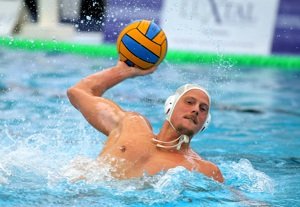Water Polo Rules

The game of Water Polo originated in Britain and it was one of the original sports featured at the the first ever modern Olympic Games in 1900. It is a dynamic team game that requires all participants to have a high level of fitness as well as a large degree of stamina. Featuring fast and furious action, it is an exciting game both to play and to watch. Each match consists of four quarters and players use a combination of swimming, treading water, throwing, catching and shooting throughout the game in an attempt to beat the opposition team. The game is overseen by FINA, the Fédération Internationale de Natation.
Object of the Game
The object of Water Polo is to work as a team with a view to putting the ball into the opposition team’s net, known as scoring a goal. Like many team sports, the object of the game is to score more goals than the opposing team, resulting in a win. It’s not unusual to see high scoring games, with each team scoring over 20 goals each.
Players & Equipment
Each team consists of seven players in the pool at any one time, consisting of six outfield players and one goalkeeper. Unlike other team games such as soccer or hockey where players have very specific positions to keep to, water polo players move from position to position as the game demands. Positions are either offensive or defensive, with the offensive positions including a centre forward, two wings who play on the flanks of the pool and a point, who is positioned around the 5m line. In terms of defensive positions, the only one set in stone is the ‘hole D’, whose job it is to steal the ball and defend the goalie and goal. Players without a set role are known as utility players and are similar to soccer’s midfield, helping out with both offense and defence.
Not much equipment is needed to play Water Polo. A net and a ball are required and players wear simple swimsuits or trunks depending on sex as well as swimming caps and goggles if required.
Scoring
In Water Polo, a goal is scored when the ball completely passes the goal posts and below the crossbar. A team may only have possession of the ball for up to 30 seconds without shooting for a goal, but if a shot is taken and the ball rebounds, the shot clock is reset and the 30 seconds begins again.
Winning the Game
At the end of a match, if a game is tied, then a penalty shootout is used to determine the winner, where all 5 players from each team shoot alternately from the 5m line. If the score remains tied, the shootout continues until one team misses and the opposition scores. Overtime and shootouts are very common in Water Polo.
Rules of Water Polo
- The playing area is 30m x 20m with a minimum depth of 2m.
- Teams consist of 13 players in total, with 7 players in play at any time, 6 field players and 1 goalie.
- Players are only permitted to use one hand to hold the ball apart from the goalie who can use two hands when within 5m of their own goal.
- Water Polo is played in four quarters with each quarter lasting for eight minutes with a two minute break between quarters.
- Players advance the ball upfield by swimming with the ball in front of them or by passing to teammates.
- Players are not allowed to touch the bottom of the pool and players tread water or swim for the entire match.
- Teams can only retain the ball for up to 30 seconds without shooting at goal.
- A goal is equal to one point and is scored when the ball is pushed or thrown completely between the goalposts and under the crossbar.
- Fouls are made up of ordinary fouls and major fouls. Players are only allowed three major fouls, any more and they are excluded out of the game.
- If at the end of the game the score remains tied, a shootout occurs to decide the winner.